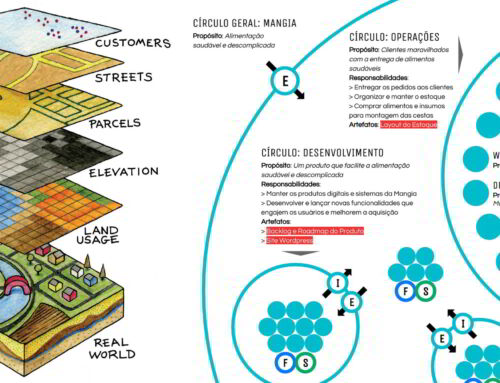Contrary to what sometimes seems to be the reality, the world of work is not populated by manipulative psychopaths who want to maintain power. In most cases, hierarchies and differences are maintained simply by force of habit. That is, in the organizational environment we have a bunch of people unaware of their habits and how these can turn into anti-patterns and impair the effectiveness of the organization as a whole. What was once a good practice is now a major constraint.
Introducing self-management is an epic challenge. We face several barriers in organizational design work: social, cognitive, technical and emotional. Technologies like O2 help a lot, especially for groups to become more aware of their interactions. It is from here that the discernment between interactions that are productive and those that are not arises.
A few weeks ago I intuitively discovered a new pattern, which makes more visible what a circle manifests when it is interacting. I’m calling it “Mirror of Interactions”. I will describe the pattern below.
Attention: this is a new and untested pattern. So use it at your own risk.
First, becoming aware
The interactions of a group clearly show how people behave when faced with different tensions. In meetings, more specifically the Circle Meetings proposed by O2 or other more informal interactions, anti-patterns such as “Everything belongs to everyone” can manifest themselves. If an individual has a preference for systematically waiting for everyone’s approval before taking action, the observant change agent can clearly watch this unfold. These are opportunities that can be exploited to help the circle or team become aware of these interactions, which are often unidentified and therefore never adapted.
We need to be clear about the interactions and mechanisms people are using to address their tensions, not just the content of a conversation and/or discussion.
How the pattern works
During synchronize mode or any meeting where the group is trying to resolve or address an important issue, the facilitator can pause the conversations and offer a summary of what was observed. This can happen after each tension is processed (in sync mode) or at the time the facilitator sees fit. While paraphrasing the facilitator can highlight things like:
- Who made the request or brought forth the issue
- What type of request was made (clarification, project, action, doubt, need for sharing)
- Who spoke and who didn’t
- Who looked or who didn’t
- Who was consulted or gave an opinion and who was not
- What the secretary did with the request made
After sharing the observations, the facilitator can also promote a reflection on the quality of the interaction by asking a few questions:
- How do you rate the quality of this interaction?
- Does this interaction represent the new distributed/self-managed power structure, or does it contain shadows of the old structure?
HOW IT CAN BE APPLIED
Imagine that you (facilitator) are participating in a circle meeting with four people. Kelly (External Link and former team manager), Roberto (a new circle member), Eloá (a less experienced member) and Yuri (the most experienced member, former coordinator).
During sync mode, Eloá brings forth a tension related to an accountability on a role she fills, called Instagram Master.
Eloá: I would like to share a strategy that I am using on Instagram and also to know your opinion about it. Last week I reduced the number of posts per week, because I realized that the engagement is the same […]. I wanted to know how you guys see this.
Roberto: If you’ve already done the experiment and the results were these, I don’t think there’s any reason to do it differently.
Kelly: I don’t think it makes sense, we need to keep our users with content. It’s not just a matter of metrics […].
Eloá: I understand Kelly, but we could also focus our energy on other more important things […].
[Conversation continues for a few more minutes]. In the end Eloá says that she is satisfied.
The facilitator observes carefully and decides to use “Mirror of Interactions”, sharing what he observed:
- Eloá brought forth a strategy that she is looking to use in her role as Instagram Master.
- Eloá says she’s following strategy A (to post less), but still asks the group’s opinion about it.
- Roberto and Kelly share their opinion. The others remain silent.
- Kelly seems to see some harm in the path described by Eloá and spends some time arguing that path B (post more) is better. Kelly seems unhappy with the option suggested by Eloá (this is an inference) and the conversation goes on.
- Eloá says she is satisfied, but her face shows the opposite (inference).
- The secretary does not record any output or action from the conversation.
The facilitator then makes room for participants to talk about the mirror and offer different views, especially on inferences. Eloá confirms that she was a little uncomfortable with the conversation. Kelly also assumes that she was trying to convince Eloá to follow path B. Afterwards, the group talks about their interaction and comes to the following conclusions:
- Eloá realizes that despite already having a path in her head (strategy A), she tries to please Kelly and include her perspective, even though she has autonomy/authority to do otherwise in her role as Instagram Master.
- Kelly admits that she was not very emphatic in her statements and that she insisted on her suggestion even though she knew that the decision-making authority belonged to Eloá.
- Yuri had an opinion on the matter, but was afraid to share it and polarize the conversation.
- Roberto didn’t notice the subtleties and found everything very calm, probably because he’s new and doesn’t know the group yet.
Expected Outcome
After repeating the “Mirror of Interactions” pattern, a group gradually begins to gain more awareness of the underlying lines of each tension. Ancient power structures appear on the surface, which gives everyone an opportunity to think about and adapt behavior.
I invite you, as change agents, to try the “Mirror of Interactions” pattern. Then comment below how your experience was. Together we can build a more effective pattern library.
Translated by Tanya Stergiou






Leave A Comment